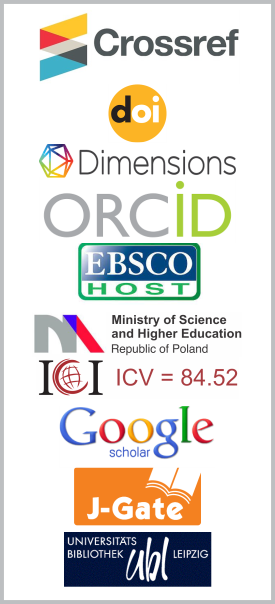Advances in Perovskite-Based Solar Cells
DOI:
https://doi.org/10.26713/jims.v9i2.747Keywords:
Hole transport material, Electron transport material, Perovskite, StabilityAbstract
The increase in energy demand due to increase in population and reduction of fossil fuels has led to the search of alternative energy sources. Solar energy, which is an alternative source of energy, has been in the fore front of this research. Various methods of converting solar energy into electricity has been attained by silicon solar cells, thin film solar cells, dye sensitized solar cells and perovskite solar cells. Unlike dye sensitized solar cells, perovskite solar cells based on lead halide perovskite or organic-inorganic halide perovskite have had a significant impact on photovoltaic devices. A power conversion efficiency of approximately 20.1% has been attained by perovskite solar cells compared to organic solar cells. Also, several fabrication techniques, hole and electron transport materials have been developed for high performance. Although, some issues need to be addressed before commercialization is possible. Issues like stability of the cells under moisture and temperature. In this review, fundamental aspects of the perovskite device and recent breakthroughs are illustrated.Downloads
References
M.A. Green, K. Emery, Y. Hishikawa, W. Warta and E.D. Dunlop, Solar cell efficiency tables (version 39), Prog. Photovoltaics: Res. Appl. 20 (2012), 12 – 20.
G. Hodes and D. Cahen, Photovoltaics: perovskite cells roll forward, Nature Photon. 8 (2014), 87 – 88.
R.F. Service, Perovskite solar cells keep on surging, Science 344 (2014), 458.
W.S. Yang, J.H. Noh, N.J. Jeon, Y.C. Kim, S. Ryu, J. Seo and S.I. Seok, High-performance photovoltaic perovskite layers fabricated through intramolecular exchange, Science 348 (2015), 1234 – 1237.
J.-H. Im, J. Chung, S.-H. Kim and N.-G. Park, Synthesis, structure, and photovoltaic property of a nanocrystalline 2H perovskitetype novel sensitizer (CH3CH2NH3)Pbl3, Nanoscale Res. Lett. 7 (2012), 353.
P. Umari, E. Mosconi and F. De Angelis, Relativistic GW calculations on CH3NH3PbI3 and CH3NH3SnI3 perovskites for solar cell applications, Sci. Rep. 4 (2014), 4467.
A. Kojima, K. Teshima, Y. Shirai and T. Miyasaka, Organometal halide perovskites as visible-light sensitizers for photovoltaic cells, Journal American Chemical Society 131 (2009), 6050 – 6051.
N.J. Jeon, J.H. Noh, W.S. Yang, Y.C. Kim, S. Ryu, J. Seo and S.I. Seok, Compositional engineering of perovskite materials for high-performance solar cells, Nature 517 (2015), 476 – 480.
J. Song, E. Zheng, J. Bian, X.F. Wang, W. Tian, Y. Sanehira and T. Miyasaka, Low-temperature SnO2-based electron selective contact for efficient and stable perovskite solar cells, Journal of Material Chemistry A3 (2015), 10837 – 10844.
X. Li, M. Ibrahim Dar, C. Yi, J. Luo, M. Tschumi, S.M. Zakeeruddin, M.K. Nazeeruddin, H. Han and M. Gratzel, Improved performance and stability of perovskite solar cells by crystal crosslinking with alkylphosphonic acid omega-ammonium chlorides, Nat. Chem. 7 (2015), 703 – 711.
L. Schmidt-Mende, H. Hu, K.K. Wong, T. Kollek, F. Hanusch, S. Polarz and P. Docampo, Highly efficient reproducible Perovskite solar cells prepared by low-temperatured processing, Molecules 21 (2016), 542.
W. Yan, Y. Li, Y. Li, S. Ye, Z. Liu, S. Wang, Z. Biana and C. Huang, Stable high-performance hybrid perovskite solar cells with ultrathinpolythiophene as hole-transporting layer, NanoRes. 8 (2015), 2474 – 2480.
Y. Wu, A. Islam, X. Yang, C. Qin, J. Liu, K. Zhang, W. Peng and L. Han, Energy Environmental Science 7 (2014), 2934.
A. Getachew, K. Martin, D.G. Eric, H.A. Dogukan, S.W. Matthew, H. Herwig, T. Sekai, S. Philipp, E. Bruno, W.K. Christian, S.S. Niyazi and M.C. Scharber, Solution processed perovskite solar cells using highly conductive PEDOT:PSS interfacial layer, Solar Energy Materials & Solar Cells 157 (2016), 318 – 325.
W. Yan, Y. Li, Y. Li, S. Ye, Z. Liu, S. Wang, Z. Bian and C. Huang, Stable high-performance hybrid perovskite solar cells with ultrathinpolythiophene as hole-transporting layer, Nano Research 8 (2015), 2474 – 2480.
M. Zhang, M. Lyu, H. Yu, J.H. Yun, Q. Wang and L. Wang, Stable and low-cost mesoscopic CH3NH3PbI2 Br perovskite solar cells by using athinpoly(3-hexylthiophene) layer as a hole transporter, Chemistry 21 (2015), 434 – 439.
J. Burschka, S. Pellet, S.J. Moon, R. Humphry–Baker, P. Gao, M.K. Nazeerudin and M. Gratzel, Nature 499 (2013), 316 – 319.
J.H. Kim, P.-W. Liang, S.T. Williams, N. Cho, C.C. Chueh, M.S. Glaz, D.S. Ginger and A.K.-Y. Jen, High–performance and environmentally stable planar heterojunction perovskite solar cells based on a solution – processed copper – doped nickel oxide hole transporting layer, Advanced Material, (2014), doi:10.1002/adma.201404189.
Downloads
How to Cite
Issue
Section
License
Authors who publish with this journal agree to the following terms:- Authors retain copyright and grant the journal right of first publication with the work simultaneously licensed under a CCAL that allows others to share the work with an acknowledgement of the work's authorship and initial publication in this journal.
- Authors are able to enter into separate, additional contractual arrangements for the non-exclusive distribution of the journal's published version of the work (e.g., post it to an institutional repository or publish it in a book), with an acknowledgement of its initial publication in this journal.
- Authors are permitted and encouraged to post their work online (e.g., in institutional repositories or on their website) prior to and during the submission process, as it can lead to productive exchanges, as well as earlier and greater citation of published work.




